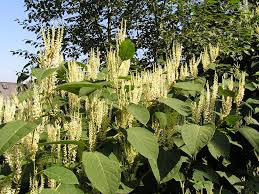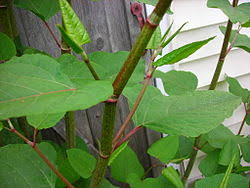Japanese Knotweed
 Common Name: Japanese knotweed
Common Name: Japanese knotweed
Scientific Name: Polygonum cuspidatum, Reynoutria japonica, Fallopia japonica
Climate: It can adapt to cold, warm and temperate climates
Plant Description: Japanese knotweed has hollow stems with distinctive nodes that make it look like bamboo, but it is a type of buckwheat, not a bamboo. It can grow up to three or four meters in height, but much smaller plants are also common. The leaves are broad and oval and are 7-14cm long and 5-12cm wide. Small cream or white flowers appear in late summer or early autumn.1
Cultivation: Japanese knotweed is a HIGHLY INVASIVE PLANT and SHOULD NEVER BE TRANSPLANTED OR CULTIVATED! It is incredibly difficult to eradicate once it takes root, and spreads very easily. It can destroy building foundations. Existing patches can be located and harvested. It is found in a variety of ecosystems and can tolerate challenging conditions. It is especially common near streams and other natural or human-created water sources.
 Uses:2,3 The root is used medicinally, and the young shoots are edible.
Uses:2,3 The root is used medicinally, and the young shoots are edible.
The root can be prepared as a tincture, decoction, or powder and has a broad range of medicinal properties. It protects blood vessels and modulates immune system response, both of which are important activities in the treatment of Lyme Disease, SARS, and COVID-19. It is a broad antiviral, with scientific research demonstrating efficacy against influenza and several other viruses. It contains resveratrol, a substance believed to promote heart health. It has antibacterial, antiviral, anti-spirochetal anti-fungal, anti-inflammatory and anti-carcinogenic properties. It should not be taken during pregnancy.
Young shoots can be harvested in spring as food, and are a good source of vitamin C. A common preparation involves soaking the shoots and peeling away the outer skin before cooking the center part.
References:
- https://en.wikipedia.org/wiki/Reynoutria_japonica
- Buhner, Stephen Harrod. Healing Lyme: Natural Healing of Lyme Borreliosis and the Coinfections Chlamydia and Spotted Fever Rickettsioses. Raven Press, 2015.
- Buhner, Stephen. Herbal Antivirals: Natural Remedies for Emerging & Resistant Viral Infections. Storey Publishing, LLC, 2013.
En español: Hierba Nudosa Japonesa
